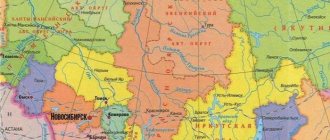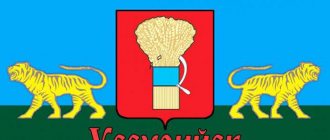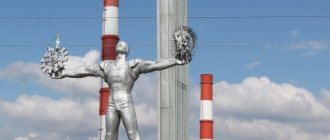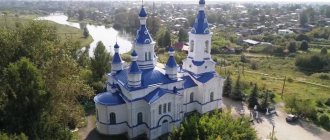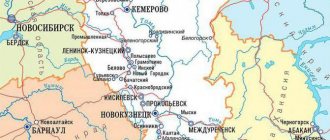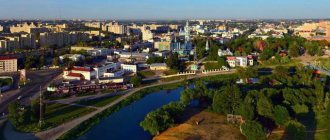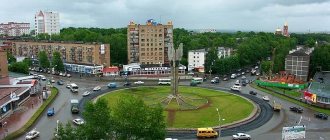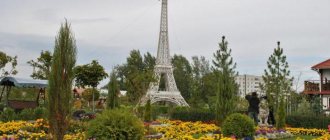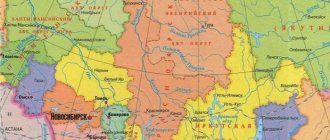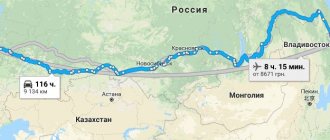History of the region
At the end of the 19th century, Jews in our country constantly experienced oppression by the tsarist authorities, so the younger generation accepted the ideas of the 1917 revolution with ardor and enthusiasm. After the victory of the Bolsheviks, Jews were given equal rights with other citizens, and the government began to think about taking measures to attract them into the ranks of ordinary Soviet workers.
In 1934, a specially created committee decided to allocate free lands in the Far East to representatives of the Jewish people. Thus begins the history of a unique autonomous region in Russia, the only one after Israel where the Jews have an officially recognized territory of their own.
Church of St. Nicholas
A fairly young Orthodox church on the territory of Birobidzhan, which was built in 1999, it is noteworthy that for the first five years after its construction the temple was the cathedral of the Birobidzhan diocese.
To this day, the shrine is regularly replenished with new icons and holy relics. Structurally, the temple is made in accordance with all Orthodox canons and is a wooden structure with four domes.
Location: Sholom Aleichem Street - 52.
Education
The reasons why the Soviet government allocated these particular lands for development and settlement are not accidental. Proximity with Japan and China dictated the need to create an outpost against possible aggression from the countries of the East.
To strengthen the borders, the territory along the Amur Railway was chosen, and the center of the new region became the former small station Tikhonkaya, where about six hundred people lived before the mass resettlement of Jews. Soon thousands of Jews with their families and belongings flocked here, but due to the geographical location and harsh climate in the places where Birobidzhan is located, more than half of the people left back after a year.
In 1937, the settlement received the official status of a city, and artels and partnerships began to open here. Information about the emergence of the Jewish Autonomous Okrug becomes known far abroad, thus the Soviet government is trying to assert its status and attract subsidies from wealthy Jews to the region.
Monument to Friendship
This monument personifies the friendship between Russia and China. It appeared in 2002. The initiators of its installation were Chinese sculptors and artists. The monument is located near the Birobidzhan City Hall; the sculpture is surrounded on all sides by a green lawn. The monument itself is a tall statue depicting two hands securely holding a ball, which is entwined with several spacecraft.
Location: Lenin street - 31.
Problems of the area
The settlers were forced to start from the very beginning; there was only taiga and swamps around, they cleared roads, improved fields, built houses and schools, and opened a newspaper. Today, few of our compatriots know where the city of Birobidzhan is located on the map of Russia, and even more so, almost no one knows why this region is attractive and famous.
After the collapse of the USSR and the adoption of a new constitution, the Jewish region remained the only autonomous region in Russia, all the others were renamed republics. In 1990, the standard of living in the Jewish Autonomous Region and neighboring regions was lower than the general level in the country, so Jews left en masse for Israel. Most of them settled in the city of Ma'alot; these people still annually hold meetings of former residents of the Jewish Autonomy and visit their native places.
Monument with the IS-3 tank
A monument with a combat vehicle appeared in Birobidzhan on the 63rd anniversary of the Great Victory. This theme for the monument was not chosen by chance, because in 1941 the 60th Tank Brigade was organized in Birobidzhan.
Of course, the tank, mounted on a pedestal, did not take part in the battles, because came off the assembly line only in 1944, but this in no way diminishes the significance of the memorial dedicated to all tank crews who died at the front.
Location: Bumagin Square.
Location
According to many historians, Stalin's attempt to resettle the Jewish population from the central region of the country was nothing more than a voluntary exile. After all, the entire territory where Birobidzhan is located, as well as the lands adjacent to it, were practically wild places. Although this part of the Far East, despite the harsh climate and constant monsoon winds, turned out to be quite suitable for life.
Favorable conditions here were made possible due to the favorable relief; the territory is surrounded by a massive mountainous region with the highest point on Mount Studencheskaya (1412 m), and in the south and east lies the Middle Amur Lowland. The largest river in the region is the Amur; freight and passenger transportation takes place here for seven months of the year. The city itself is located on the banks of one of the small rivers, the Bira, a little further - Bidzhan, they flow parallel to each other and flow into the great Siberian river.
Reviews from tourists about Birobidzhan
The city leaves a good impression on most travelers. Many consider it an excellent starting point for exploring the Far East. The following facts support this statement:
- Favorable geographical location. From here it is convenient to reach such regional attractions as the Lotus Lake, the natural complex "Bidzhan Outcrop", the Londakovskaya and Pasechnaya caves.
- Availability of hotel infrastructure. City hotels offer accommodation options in economy, standard, business, and luxury categories.
- Reasonable prices. The cost of renting hotel rooms, services, food, and groceries is affordable even for tourists with modest incomes.
The city has everything you need to have a wonderful few days of vacation. Colorful photos of the sights of Birobidzhan will long remind you of an exciting journey through the Far East.
Climate and nature
Winters are quite mild and dry, and summers are hot and humid. The favorable climate allows you to grow almost any crop: grains, vegetables, potatoes and even melons.
Rich forest lands where ancient fir, oak and other deciduous trees grow, ponds full of fish, diverse wildlife - all this makes the main city of the Jewish Autonomous Region, Birobidzhan, truly unique and attractive. Climate, ecology, fertile lands and minerals allowed the region to develop independently and provide the inhabitants of the region with everything.
Natural attractions of Birobidzhan
In the vicinity of the policy there are several places that are especially attractive to connoisseurs of natural beauty. A walk along the tourist trail of the Bastak dendrological park will be remembered by travelers as vivid impressions. Cedars, fir, spruce, deciduous trees and shrubs grow here, the air is filled with aromas, springs exude crystal clear water.
Not far from the village of Golovino, Birobidzhan region, there is the amazing Swan Lake. In summer, the buds of the Komarov lotus bloom on its surface. Nature lovers from all over the region come to see the carpet woven by nature from delicate pink inflorescences and white petals of water lilies. The lake is rich in fish. The bottom silty sediments of the reservoir were chosen by a species of the same age as dinosaurs - the relict water chestnut.
Population composition
Despite the name Jewish Autonomous Region, the proportion of people professing Judaism is quite low. According to the 2010 census, of the 160 thousand people living in this territory, only 1% considered themselves to be Jewish people, that is, where Birobidzhan is located, about 1,600 Jews live. Most of them speak Russian, a little less Hebrew, and a very small proportion of those who still remember Yiddish.
Many people here have Jewish roots or have relatives who went to Israel or other Western countries. Almost all residents of the region call themselves citizens of Russia and have the appropriate passports. The traditions of Judaism still live and coexist peacefully with Russian, Chinese and other cultures. Today, in the main city of the region there is a people's university, a Freud club, and festivals and congresses of Jews are held annually.
Sholom Aleichem Library
It is the largest in Birobidzhan. She was named after the most famous Jewish literary figure, who wrote in three languages, including Russian. This library has a very significant book collection; it is believed that it is possible to find almost any literature here. The library is located in a small building designed by the architect Kobzar.
Location: Lenin street - 25.
Heraldry
Our country has many interesting places and areas about which comprehensive information can rarely be found; one of such regions is the Jewish Autonomous Okrug and its capital Birobidzhan. Where is? The country and the city and this region do not particularly stand out; in general, it does not even have a special history or recognizable traditions.
In 2005, the city administration decided to somewhat change this injustice and issued a resolution to create its own coat of arms. The Duma approved this position and the Jewish Autonomous Region finally received its own special identity. The emblem is a blue (azure) shield over six white stripes emanating from a green hill, in the middle of the design is a thin silver spear; The green hemisphere below is complemented by a white one with three azure wriggling belts. All images are easily recognizable to local residents: a traditional hill, a television tower, a stylized image of a minor tree.
For the first time, the creation of the city’s own symbols was undertaken back in the USSR, then the head of the city executive committee organized a competition in the newspaper and awarded cash prizes. But the administration did not support the initiative, and for another thirty years the settlement remained without a coat of arms.
Economy
Almost all large enterprises in the city were founded in Soviet times, during the period of active settlement of the region. The capital of the autonomous region has developed light and food industries. In those places where the city of Birobidzhan is located, arable land is used particularly successfully; every year more and more fields suitable for crops appear, so there is no shortage of its own products for processing here.
There are shoe and clothing factories in the capital of the autonomy, some of which are also known in neighboring regions of the country: Elegant OJSC, Rostok, the Molly dairy plant, and furniture, transformers and pasta are also produced here. Not far from the place where the sawmill is located in Birobidzhan 2, the Trans-Siberian Railway passes through the city, so communications with other regions and the center are sufficiently developed. In addition, the capital of the joint-stock company is located near the border with China, thanks to which trade relations have long been established between the two countries.
To provide the population with electricity, it operates its own thermal power plant. All Russian mobile operators and representatives of well-known Internet providers work.
City infrastructure
Birobidzhan is a compact city; buses, minibuses and taxis run along city routes. According to the assessment of the auto expedition of the Popular Front “Let’s evaluate the quality of roads”, the city’s roads can be rated “good”.
Birobidzhan roads and the Velikan shopping center - high-quality asphalt pavement and retail park
Intercity communication is provided by buses and trains. The Trans-Siberian railway line runs through Birobidzhan, the nearest airport is in Khabarovsk - 170 km away. The number of cars on city roads has increased significantly, but there are no traffic jams.
Roads in Birobidzhan - bridge over the river. Bira
The housing and communal services system is maintained in satisfactory condition: HOAs are being created, management companies are operating, some of them were created by developer enterprises and service new buildings. The average bill for a 3rd apartment with an area of 86 sq. m. m. for housing and communal services in the summer in a house built in 2009, without heat, is 2,500 rubles, the bill for heat in the winter will be 3,000 rubles.
All houses in the city, except for new buildings in the last three years, are provided with gas supply. Recently, developers have refused to gasify new buildings and are installing electric stoves.
The city has 18 kindergartens, 13 schools, one local university, several branches of Khabarovsk and Amur universities, as well as 8 colleges.
Kindergartens are overcrowded, but due to the dense staffing of the groups, all children are provided with places by the age of three. Free sports sections are available at the Children's Creativity Center, reconstruction of the central city stadium is underway, and construction of an ice palace is also planned.
There are two swimming pools on the basis of the Central Children's Center and school No. 1. Birobidzhan courtyards do not have enough hockey rinks, football fields and equipped children's play areas.
The most acute problem in the city is the lack of specialized medical specialists. There is only one children's clinic and hospital in the city, built in the 50s. The building has not undergone a major renovation for a long time; an attempt to introduce electronic recording to relieve queues was unsuccessful. The same picture is observed in the adult healthcare system. With all this decline in free healthcare, paid medical centers are growing like mushrooms. Many residents go to China or Korea for better quality medicine, since it is much closer to get to them than to Moscow.
Birobidzhan is oversaturated with shopping centers; branches of large retail chains are opening.
Shopping complex "Megapolis" on a pedestrian street
Culture
During the period of mass emigration of Jews from the USSR to Israel and later, already in the difficult 90s of the 20th century, the region lost a lot in social and spiritual terms. Much in the appearance of the city still speaks of the presence of the Jewish people here: for example, on the station square there is a monument in the form of a minor, and next to it is a bronze figure of one of the heroes of Jewish mythology. In addition, there are two synagogues here, the third burned down under Khrushchev.
All cultural institutions appeared here in Soviet times: the regional philharmonic, the puppet theater, the Rodina cinema, a theater and several museums. In recent years, activists for the revival of the region have been seeking funds for the restoration and restoration of the city’s cultural buildings.
In the territory where Birobidzhan is located, all major television channels and radio stations broadcast, and there is also its own local television. There are two stadiums, several swimming pools and children's sports and dance schools. Martial arts sections, chess, boxing are especially developed, and they even have their own diving club.
Interesting features
Many of those who previously left for Israel or America still do not forget their hometown and often come to Birobidzhan. Representatives of the chosen people know and remember where the country that became the first officially recognized Jewish center is located. Some activists and supporters of the revival of true Judaism in Russia chose Birobidzhan as a place to promote Yiddish; here it is taught to anyone who wants it. So, in the classrooms you can meet Russians, Chinese, Ukrainians and Koreans.
In 1990, with the support of the Russian government, a branch of the Institute of National Educational Problems was created here. In this educational institution, issues are discussed and methods are developed for the development of Jewish education in our country.
Many famous people are considered to be natives of the capital of the autonomy or those who lived here at one time or another. Among them are heroes of the Soviet Union, musicians, composers, such as Z. I. Shersher, founder of the world Grammy Award, or A. Yu. Gorshenev, vocalist of the Kukryniksy group. As well as Russian actors and public figures: Semyon Strugachev, Sherlig Yu. B. and Colin I. M.
[edit] Zugunders
End of the 17th
- instead of telling you to fuck off in a humane and cultural manner, you will be asked to take bus route 17, which goes exactly to the local mental hospital.
| [ + ] Birobidzhan is part of the harsh reality of this country. | |||||||||||||||||
| |||||||||||||||||
| [✡ ] | |||||||||||||||||
| |||||||||||||||||
Tourism
The state program for the development of the Far Eastern regions of Russia, promoted over the past ten years, has had its notable successes. New ways to travel have opened up for residents of our country, advertising of their native regions and the creation of the necessary infrastructure have led to the fact that the number of tourists in the Jewish Autonomous Region has increased significantly, especially where Birobidzhan, the capital of the autonomy, is located. Moreover, not only our compatriots are coming, but also residents of Korea, China, Japan and Israel.
The main attraction of the region is its stunning nature; it is easy to find places untouched by man and have a pleasant time on the river or in the mountains. Lovers of urban beauty also have something to marvel at here. Already at the entrance to the city, the tourist is greeted by a monumental monument of Soviet architecture - the railway station, and here in the square in the fountain you will see the most recognizable symbol of the Jewish faith - the menorah.
On the street where the model of the globe is located in Birobidzhan, guests from neighboring countries often like to walk. Here you can find many monuments dedicated to Jewish culture and the problems of developing the region. Lovers of classical music must visit the regional philharmonic and theater.
Map
Birobidzhan: photo from space (Google Maps) Birobidzhan: photo from space (Microsoft Virtual Earth)
| Birobidzhan. Nearest cities. Distances in km. on the map (in brackets along roads) + direction. Using the hyperlink in the distance , you can get the route (information courtesy of the AutoTransInfo website) | |||
| 1 | Smidovich | 67 (73) | IN |
| 2 | Teploozersk | 80 (87) | Z |
| 3 | Leninskoe | 97 (133) | YU |
| 4 | Nikolaevka | 138 () | IN |
| 5 | Obluchye | 139 (163) | Z |
| 6 | Khabarovsk | 160 (174) | IN |
| 7 | Korfovsky (Khabarovsk Territory) | 168 (201) | IN |
| 8 | Nekrasovka (Khabarovsk Territory) | 175 (194) | IN |
| 9 | Khor (Khabarovsk Territory) | 180 (256) | SE |
| 10 | Pereyaslavka (Khabarovsk Territory) | 181 (272) | SE |
| 11 | Amurzet | 183 (239) | SW |
| 12 | Prince-Volkonsky (Khabarovsk Territory) | 188 (208) | IN |
| 13 | Vyazemsky | 193 (301) | SE |
| 14 | Arkhara (Amur region) | 220 (264) | Z |
a brief description of
Located in the Middle Amur Lowland, on the river. Bira (tributary of the Amur), 172 km west of Khabarovsk. Railway junction lines and highways.
Territory (sq. km): 169
Information about the city of Birobidzhan on the Russian Wikipedia site
Historical sketch
It arose as a village at Tikhonkaya station (opened in 1915). Since October 10, 1931, the working settlement of Tikhonkaya. In 1932, it was renamed Birobidzhan after the name of the area Birobidzhan: this was the name given to the space between the rivers Bira (Evenki “river”) and Bidzhan (Evenki bijen “permanent camp”).
Since 1934 the center of the Jewish Autonomous Region. City since 1937.
In the pre-war years, light industry was formed (knitting, textile, shoe, and textile factories).
Municipal indicators
| Index | 1990 | 1999 | 2001 | 2003 | 2005 |
| Demography | |||||
| Number of births, per 1000 population | 16 | 8.7 | 10.3 | 12.2 | 11.2 |
| Number of deaths, per 1000 population | 8.9 | 12.5 | 13.5 | 14.6 | 16.7 |
| Natural increase (decrease), per 1000 population | 7.1 | -3.8 | -3.2 | -2.4 | -5.5 |
| Standard of living of the population and social sphere | |||||
| Average monthly nominal accrued wages, rub. | 0.329 | 1576.3 | 3114.8 | 5674.9 | 8680.3 |
| Average housing area per inhabitant (at the end of the year), sq.m. | 14.6 | 18.8 | 19.2 | 19.5 | 20 |
| Number of preschool institutions, pcs. | 45 | 19 | 17 | 17 | 17 |
| Number of children in preschool institutions, thousand people | 7.1 | 2.6 | 2.7 | 3.1 | 3.3 |
| Enrollment of children in preschool educational institutions (at the end of the year), as a percentage of the number of children of the corresponding age, % | 73.1 | 71.4 | |||
| Number of daytime educational institutions (at the beginning of the school year), pcs. | 14 | 16 | 16 | 15 | 15 |
| Number of students in daytime educational institutions, thousand people | 12.5 | 12.8 | 11.8 | 10.4 | 8.9 |
| Number of doctors, people. | 474 | 474 | 448 | 437 | 457 |
| Number of nursing staff, people. | 1244 | 1133 | 1185 | 1145 | 1176 |
| Number of hospital institutions, pcs. | 8 | 7 | 7 | 7 | 7 |
| Number of hospital beds, thousand units | 1.8 | 1.2 | 1.3 | 1.3 | 1.3 |
| Number of medical outpatient clinics, pcs. | 9 | 19 | 16 | 16 | 15 |
| Capacity of medical outpatient clinics, visits per shift, thousand units. | 1.9 | 1.9 | 1.8 | 1.8 | 1.7 |
| Number of registered crimes, pcs. | 1356 | 2977 | 3265 | 2941 | 2536 |
| Persons who committed crimes were identified, persons. | 899 | 1261 | 1084 | 863 | 673 |
| Economy, industry | |||||
| Number of enterprises and organizations (at the end of the year), pcs. | 1796 | 2021 | 2387 | 2606 | |
| Number of operating enterprises by type of activity: mining (at the end of the year), pcs. | 2 | ||||
| Number of operating enterprises by type of activity: manufacturing (at the end of the year), pcs. | 59 | ||||
| Number of operating enterprises by type of activity production and distribution of electricity, gas and water (at the end of the year), pcs. | 12 | ||||
| Volume of shipped goods of own production by type of mining (in actual prices), million rubles. | |||||
| Volume of shipped goods of own production by type of manufacturing (in actual prices), million rubles. | 452.6 | ||||
| Volume of shipped goods of own production by type of production and distribution of electricity, gas and water (in actual current prices), million rubles. | 533.9 | ||||
| Construction | |||||
| Volume of work performed by type of activity “Construction” (until 2004 - volume of work performed under construction contracts), million rubles. | 0.07 | 72.6 | 130.5 | 338.2 | 547 |
| Commissioning of residential buildings, thousand sq.m. of total area | 38.6 | 5.1 | 2.8 | 3.8 | 10.3 |
| Commissioning of residential buildings, apartments | 88 | 55 | 77 | 157 | |
| Commissioning of preschool institutions, places | |||||
| Commissioning of educational institutions, places | |||||
| Commissioning of hospital facilities, beds | 48 | 30 | |||
| Commissioning of outpatient clinics, visits per shift | 200 | ||||
| Transport | |||||
| Number of bus routes (in intracity traffic), pcs. | 15 | 24 | 25 | 23 | |
| Number of passengers transported by buses per year (in intracity traffic), million people. | 36.3 | 29.7 | 32.3 | 31.7 | 6.8 |
| Connection | |||||
| Number of telephone sets of the city public telephone network, thousand units. | 13 | 16.5 | 18.1 | 19.9 | 25 |
| Number of residential telephone sets of the city public telephone network, thousand units. | 8.3 | 12.6 | 13.8 | 15.3 | 19.9 |
| Number of payphones of the city telephone network (including universal ones), pcs. | 100 | 100 | |||
| Trade and services to the population | |||||
| Retail trade turnover (in actual prices), million rubles. | 1000.7 | 1845.6 | 3416.6 | 5634.9 | |
| Retail trade turnover (in actual prices), per capita, rub. | 12385 | 23333 | 44314 | 74235 | |
| Index of physical volume of retail trade turnover, % compared to the previous year | 112.8 | 109.7 | |||
| Index of physical volume of public catering turnover, % compared to the previous year | 110.2 | 113.2 | |||
| Number of stores, pavilions (at the end of the year), pcs. | 32 | 15 | |||
| Sales area of shops, pavilions (at the end of the year), sq.m. | 2184 | 2657.4 | |||
| Volume of paid services to the population (in actual prices), million rubles. | 0.034 | 189.7 | 365.5 | 660.8 | 1359.7 |
| Volume of paid services to the population (in actual prices), per capita, rub. | 0.4 | 2347.9 | 4621.3 | 8570.3 | 17914.9 |
| Volume of household services to the population (in actual prices), million rubles. | 0.009 | 39.2 | 62.6 | 76.2 | 112.8 |
| Volume of household services to the population (in actual prices), per capita, rub. | 0.099 | 485.3 | 792.1 | 988.8 | 1485.8 |
| Investments | |||||
| Investments in fixed assets (in actual prices), million rubles. | 0.14 | 40.9 | 139.3 | 547.3 | 2006.1 |
| Share of investments in fixed assets financed from budgetary funds in the total volume of investments, % | 58.8 | 40.4 | 47 | 65 | 80 |
Development prospects
Due to the remoteness in the central district of Russia, almost no one knows what the city of Birobidzhan is, where the region is located, and not every schoolchild can show it on the map. Nevertheless, this part of the huge country has, although small, its own special history. Having emerged as a Jewish autonomous region, it very soon lost its original purpose, because today Jews constitute an absolute minority of the total population - 1%.
Therefore, the future fate of the region has been actively discussed for several years. At the beginning of 1990, many advocated the abolition of the region altogether; former Prime Minister Yevgeny Primakov and some political scientists spoke in favor of this idea. Within the district itself and in Birobidzhan, activists immediately appeared advocating the preservation of a special vector for the development of autonomy.
To date, all the talk has remained just talk; in order to carry out the procedure for abolishing the Jewish Autonomous Region, it is necessary to remove one of the clauses of the Constitution that affirms its autonomy. This means that the convening of the Constitutional Commission is required, but so far no real actions have been taken.
Modern Art Museum
The museum opened in 1989, the first exhibition was called “The Old Testament through the Eyes of Contemporary Artists.” Soon the exhibition became widely known outside Birobidzhan and received a lot of reviews around the world.
Today the museum operates quite successfully, its exhibition changes once a month, and, as a rule, there is no specific theme. The walls of the museum house children's drawings, computer graphics, personal exhibitions of artists, and even exhibitions where one painting is presented.
Location: Sholom Aleichem Street - 11.
